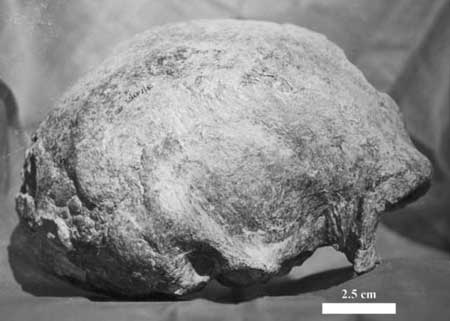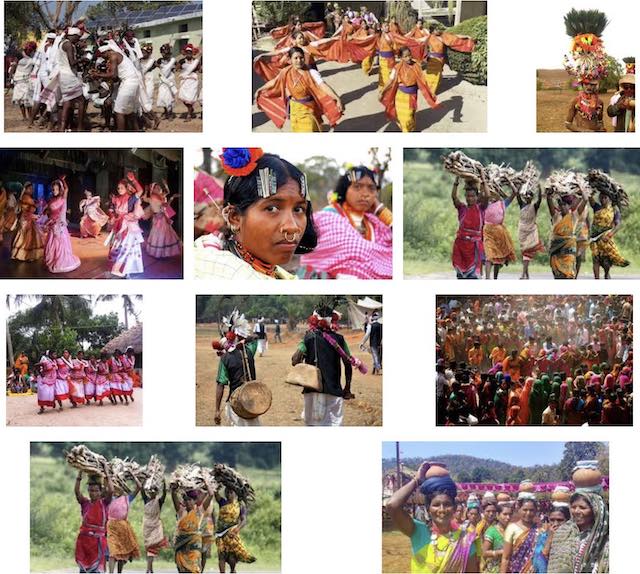
Was India home to one or more unknown hominin species, fossils of which we have not yet been discovered? And did they interbreed with the pre-existing hominid groups in the region?
There is no definitive theory that can answer these questions but archaeologists agree that most of these scenarios are possible. What they also agree is that they need to literally dig deeper and wider for the answers to these fascinating questions. With archaeologists busily hunting for artefacts and even fossils of the first modern humans in India, the wait may not be long.
Source: “Ramapithecus, Sivapithecus & Narmada Man: India’s Earliest Inhabitants” by Sanchari Pal, TheBetterIndia.com, 18 March 2017
URL: https://www.thebetterindia.com/91960/ramapithecus-sivapithecus-narmada-man-homo-erectus-early-humans-india/
Date Visited: 21 March 2024
MP: 50,000-year-old archaeological remains discovered in Narmada valley
The excavation carried out in the Narmada valley at Mehtakhedi village under Khargone district has led to the discovery of 350 archaeological remains which the experts claim to be 50,000 years old.
Source: MP: 50,000-year-old archaeological remains discovered in Narmada valley | india-news | Hindustan Times Mar 13, 2017
Address: https://www.hindustantimes.com/india-news/mp-50-000-year-old-archaeological-remains-discovered-in-narmada-valley/story-z7nQYgxard3jP0DzS4fLJN.html
Date Visited: 21 March 2024
Through the largest exploration exercise ever undertaken, M S University’s Department of Archaeology and Ancient History […] and Indiana-based Stone Age Institute at Gosport have joined hands for the ‘Narmada Basin Paleoanthropology Project (NBPA)’ with the target to collect all the paleoanthropological evidence within the last two million years. […]
Study at Narmada Basin is important because of its geographical location which is very strategic for migration of animal population from North to South and East to West. It is not only rich in fossils and archaeological sites, but it has a long history of human occupation and this region is facing submergence due to dam construction […]
Source: “Was Narmada valley the centre of human evolution?” by Prashant Ruperal, Times of India, 14 August 2012
Address: https://timesofindia.indiatimes.com/city/vadodara/Was-Narmada-valley-the-centre-of-human-evolution/articleshow/15485975.cms
Date Visited: 21 March 2024
This sacred site is also a cultural capital of the tribal people of Madhya Pradesh
Rewa: the jumping one. Maikal Suta: the one born of the Maikal Hills. Shiva’s child. Mother of the tribals. One of India’s seven holy rivers. The only one whose parikrama is performed by devotees. The Narmada River embodies all this and more. She is accorded the same status as the Ganga and Saraswati; virtue accrues by bathing in, or paying homage to these rivers. At Amarkantak, you can follow this river, which the native communities of this region call ‘Ma Rewa’, from her divine source where she begins her tentative journey through green sal woods and black basalt rocks, to her more efficient march down to the plains. Amarkantak is really a hamlet; most of it lies along a main road, which comprises a market with a few dhabas, ashrams and the Narmada Temple complex. Amarkantak is also the place to realise that the tribal idyll described by websites is now a fissured one. The tribals are now working blue-collar jobs. The forests, in the words of a local, are ‘hollow’. And the Narmada continues to push forward facing 30 big dams, 135 medium dams and 3,000 small dams en route to the Arabian Sea.
Source: “A Quick Guide To Amarkantak”, Outlook Magazine (Traveller), 1 April 2017
Address: https://www.outlookindia.com/outlooktraveller/destinations/madhya-pradesh-quick-guide-amarkantak/
Date Visited: Mon Apr 17 2017 22:44:07 GMT+0200 (CEST)
In 1973, 24 years after setting up Anandwan, a refuge for persons with leprosy in Maharashtra’s Chandrapur district, Baba Amte travelled 225km eastwards to set up the LBP for the Madia Gond tribe living in the forests of Gadchiroli. Then, as now, the tiny hamlet of Hemalkasa, where the Indravati river merges with its tributaries—the Parlkota and the Pamul Gautami that flows through the densely forested Narayanpur-Jagdalpur-Gadchiroli range—was cut off from the more developed districts. Forest dwellers died of dysentery, cholera and malnutrition. Government aid seldom found its way there. His son Prakash, then newly married, left his postgraduation studies and settled there. The young couple started a makeshift hospital for the tribals. In 1976, they also started a school under a tree, beginning with 20 tribal children.
By this time, Baba Amte had become well known for working with those marginalized and ostracized by society. In 1967, he had embarked on a project for cured leprosy patients to practise agriculture. With a large group of Anandwan residents, he started Somnath, spread over 1,300 acres in the forests of Tadoba; the project now provides all the grains and vegetables consumed at both Anandwan and Hemalkasa.
When Baba Amte and Prakash got involved with the LBP, elder son Vikas stayed back at Anandwan. Over the years, Vikas and his wife Bharati—both doctors as well—modernized Anandwan, mixing scientific temper with grass-root innovation. They shared the late Baba Amte’s vision of Anandwan as a place where everyone would get a chance at a better life, one of equality, dignity and opportunity. […]
1990: Shifts to Madhya Pradesh to support the Narmada Bachao Andolan; goes on to build and live in the Nijibal ashram in Kasrawad, on the banks of the Narmada river, to protest against the building of the Sardar Sarovar dam that would displace thousands of tribals. Wins the Templeton Prize for progress in religion.
1999: To protest against the Supreme Court order that allowed the height of the dam on the Narmada river to be raised, leads a march of thousands with activists Medha Patkar and Swami Agnivesh, from Madhya Pradesh to Delhi. He is arrested and taken to Ram Manohar Lohia hospital in New Delhi. Wins the Gandhi Peace Prize the same year.
2000s: Failing health forces Baba Amte to return to Anandwan.
9 February 2008: Baba Amte dies in the wee hours of the morning, in the Anandwan ashram. He was 94.
Source: 100 years of Baba Amte – Livemint
Address: https://www.livemint.com/Leisure/hXutfFX4xgsCs8rgqFBDrI/100-years-of-Baba-Amte.html
Date Visited: 11 August 2017
Vijay Lapalikar, Indian Express (Opinion), New Delhi, December 28, 2015 | To read the full obituary for Brahma Dev Sharma (1931-2015), click here >>
Destiny took away Brahma Dev Sharma (B.D. Sharma) from us on December 6, the Mahaparinirvan Din of Babasaheb Ambedkar. While Ambedkar remains the original icon of the oppressed classes, mainly Dalits in Hindu society, Sharma will be remembered for his contribution to the emancipation of the tribals. […]
He would recall how farmers were forced to repay loans at over 14 per cent when the original British laws of 1884 provided for 4 per cent interest with a repayment span of 35 years. […]
Vested interests were hostile to Sharma’s dogged fight against the usurpation of tribal resources by the government and private entities. […]
A lesson from an experiment in a Bastar village guided him throughout his life. He had built an “ideal village” with facilities like school and hospital. But no tribal would shift there. He realised it was best to ask the tribals what they needed and make plans accordingly rather than thrust one’s own ideas upon them. […]
Sharma was, as health activist Abhay Bang described, “the Mahatma of the tribals”.
Source: Mahatma of the tribals | The Indian Express
Address: https://indianexpress.com/article/opinion/columns/mahatma-of-the-tribals/
Date Visited: 21 March 2024
The Narmada, also called the Rewa, is a river in central India and the fifth longest river in the Indian subcontinent. It is the third longest river that flows entirely within India, after the Godavari, and the Krishna. It is also known as “Life Line of Madhya Pradesh” for its huge contribution to the state of Madhya Pradesh in many ways. It forms the traditional boundary between North India and South India and flows westwards over a length of 1,312 km (815.2 mi) before draining through the Gulf of Khambhat into the Arabian Sea, 30 km (18.6 mi) west of Bharuch city of Gujarat. […]
States: Madhya Pradesh, Maharashtra, Gujarat
Source: Narmada River – Wikipedia
Address: https://en.wikipedia.org/wiki/Narmada_River
Date Visited: Mon Apr 17 2017 23:01:56 GMT+0200 (CEST)
[Bold typeface added above for emphasis]
What the Sardar Sarovar megadam on the Narmada River means to the lives and future of millions of people: Interview in Frontline Magazine (from the publishers of The Hindu) >>

Learn more about Baba Amte and the Narmada valley on Safe search >>
See also
Forest Rights Act (FRA) | Legal rights over forest land
Health and nutrition | Recommendations by the Expert Committee
People’s Archive of Rural India (PARI) | RuralIndiaOnline.org
States along the Narmada river’s course (source to Arabian Sea):
Madhya Pradesh | Maharashtra | Gujarat
Up-to-date reports by Indian experts and journalists
Search tips
Combine the name of any particular state, language or region with that of any tribal (Adivasi) community.
Add keywords of special interest (music, poetry, dance just as health, sacred grove and biodiversity); learn about the rights of Scheduled Tribes such as the “Forest Rights Act” (FRA); and the United Nations “Declaration on the Rights of Indigenous Peoples”, “Universal Declaration of Human Rights”, “women’s rights”, or “children’s right to education”.
Ask a question that includes “tribal” or “Adivasi”, for instance: “Adivasi way of life better?” (or “tribal way of life worse?”)
Specify any particular issue or news item (biodiversity, bonded labour and human trafficking, climate change, ecology, economic development, ethnobotany, ethnomedicine, global warming, hunter-gatherers in a particular region or state, prevention of rural poverty, water access).
For official figures include “scheduled tribe ST” along with a union state or region: e.g. “Chhattisgarh ST community”, “Himalayan tribe”, “Scheduled tribe Tamil Nadu census”, “ST Kerala census”, “Particularly Vulnerable Tribal Group Jharkhand”, “PVTG Rajasthan”, “Adivasi ST Kerala”, “Adibasi ST West Bengal” etc.
In case the Google Custom Search window is not displayed here try the following: (1) toggle between “Reader” and regular viewing; (2) in your browser’s Security settings select “Enable JavaScript” | More tips >>
Note: hyperlinks and quotes are meant for fact-checking and information purposes only | Disclaimer >>
List of websites covered by this Google custom search engine
Academia.edu (platform for academics to share research papers) – www.academia.edu
Archive.org – https://archive.org
Centre for Science and Environment – https://www.cseindia.org
Current Conservation – https://www.currentconservation.org
Development and Cooperation (D+C) https://www.dandc.eu
Down To Earth (India) – www.downtoearth.org.in
India Environment Portal – www.indiaenvironmentportal.org.in
Harnessing Nature Magazine – https://harnessingnature.online
Mongabay-India – https://india.mongabay.com
M S Swaminathan Research Foundation – www.mssrf.org
Navdanya (protecting India’s biodiversity based food heritage) – https://navdanya.org
Third World Network (Penang, Malaysia) – https://twn.my
The Shola Trust (nature conservation in the Nilgiri region) – www.thesholatrust.org

Indian online periodicals and platforms | Images view >>
~ ~ ~
Personalize your CustomSearch by combining other search words >>
(e.g. name of a tribal community and region, a craft, or dance and puppetry)
Research the above issues with the help of Shodhganga: A reservoir of theses from universities all over India, made available under Open Access >>
Note: hyperlinks and quotes are meant for fact-checking and information purposes only | Disclaimer >>